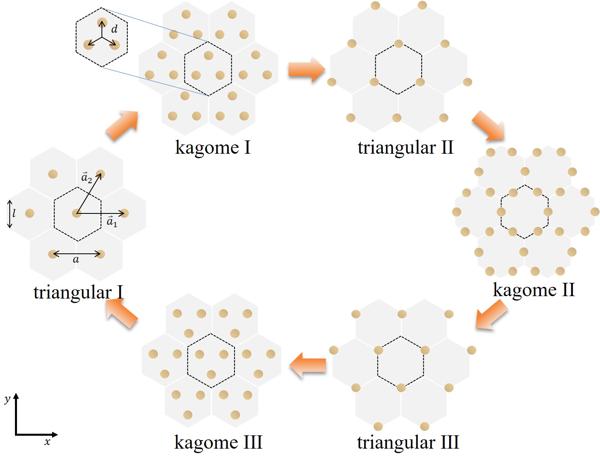Topological phases and phase transition have been extensively studied in electronic, photonic, and acoustic systems in the past decades. Recently, a new class of topological insulators, called higher-order topological insulators (HOTIs) that are characterized by higher-order bulk-boundary correspondence, were discovered.
As an excellent platform to study higher-order topological phase and phase transition, breathing kagome lattice has attract much attention. In the breathing kagome lattice, the higher-order topology is characterized by the quantized bulk polarization (or the position of the Wannier center): when there is a mismatch between the Wannier center and the lattice site, the breathing kagome lattice becomes a higher-order topological phase. On the contrary, the breathing kagome lattice becomes a topological trivial phase when the Wannier center overlaps with the lattice site.
Despite extensive studies on HOTIs based on the breathing kagome lattice, most studies only distinguish a single higher-order topological phase from the trivial phase. Does there exist any other high-order topological phases in the kagome lattice? What are the physical effects caused by the phase transitions of different high-order topological phases? These issues are still worthy of in-depth study.
The research group led by Dr. Hai-Xiao Wang from Guangxi Normal University and Prof. Jian-Hua Jiang from Soochow University unveiled multiple higher-order topological phases and phase transitions in C3-symmetric 2D photonic crystals (PhCs). The research results are published in Photonics Research, Volume 9, No. 9, 2021 (Hai-Xiao Wang, Li Liang, Bin Jiang, Junhui Hu, Xiancong Lu, Jian-Hua Jiang. Higher-order topological phases in tunable C3 symmetric photonic crystals[J]. Photonics Research, 2021, 9(9): 09001854).
The work is based on the C3 symmetric PhCs to consist of three identical dielectric rods with permittivityε=15 and radii r=0.1a. By moving the three dielectric rods along the three symmetry lines, the PhC undergoes a continuous geometry transformation that includes three triangular lattice configurations (denoted as triangular I, II and III) and three kagome lattice configurations (denoted as kagome I, II and III), as shown in Fig.1.

Fig.1 Geometric transitions in 2D PhCs with C3 symmetry.
The calculated spectrum shows the first band gap closes and reopens during the geometric transition, indicating the phase transition. To this end, the authors employed two ways to define the higher-order topological phases: (1) the Wannier center positions; (2) the symmetry eigenvalue at high symmetry points.
To demonstrate the higher-order topology, the authors construct a large triangular supercell, which the outer and inside PhCs are varied. The results show that the edge and corner states emerge between two PhCs with distinct topology.
In addition, inspired by the fact that the higher-order band topology can manifest itself in the fractional corner charge, the authors define a photonic analog of "charge" through the local density of states, and calculate the fractional "charge" of triangular supercell in different PhC configurations, which enrich the characterization method of higher-order topological phases in PhCs.
The most important significance of this work is that: (1) it connects the geometric relationship between two C3 symmetric PhCs, i.e., triangular lattice PhC and kagome lattice PhC; (2) it points out that the different primitive cell configurations with same lattice structure could correspond to distinct topological phases; (3) it is pointed out that the mechanism of higher-order topological corner states can be described by the tight-binding model. This work shows that continuously configurable dielectric PhCs can be useful generating topological photonic circuits with tunable edge and corner states.


